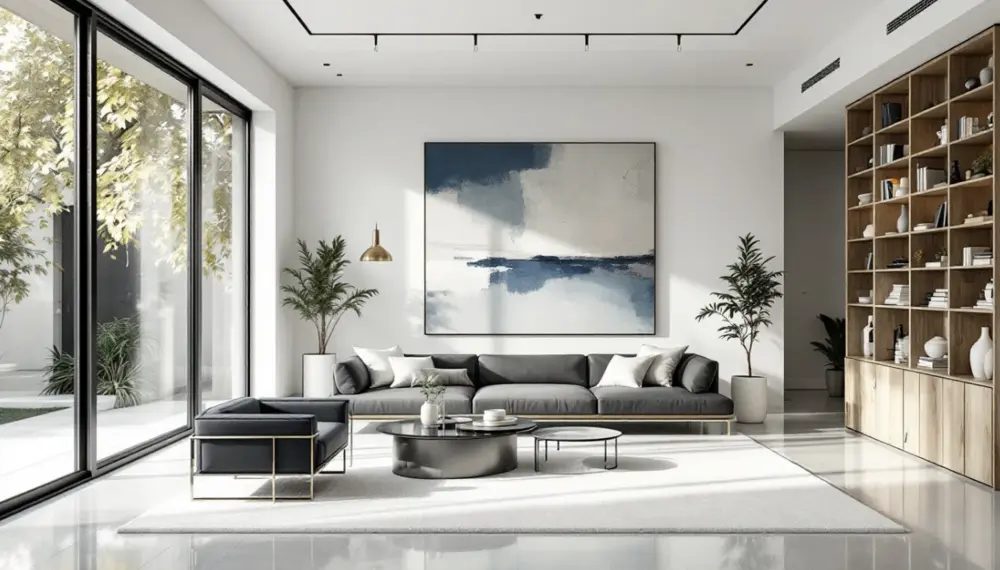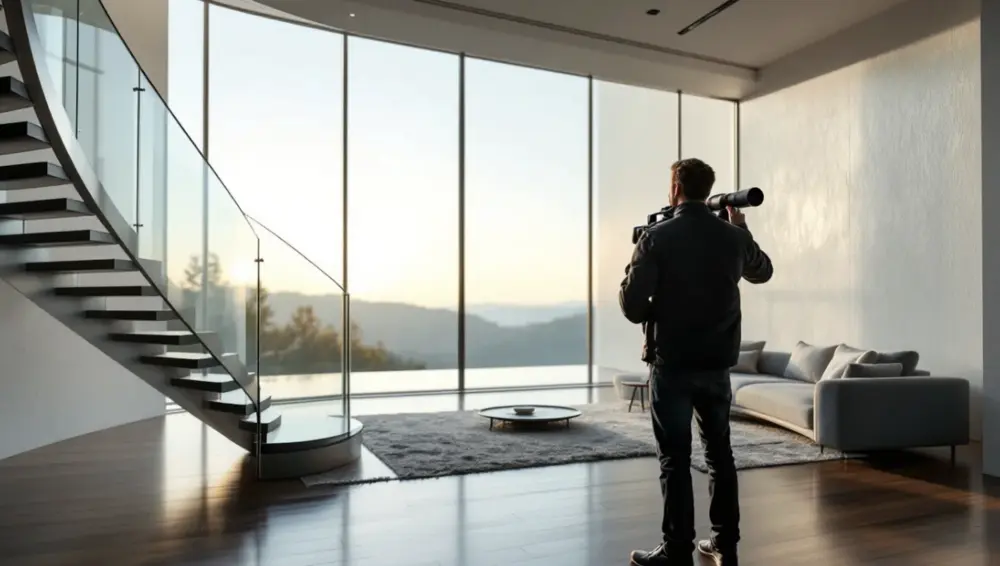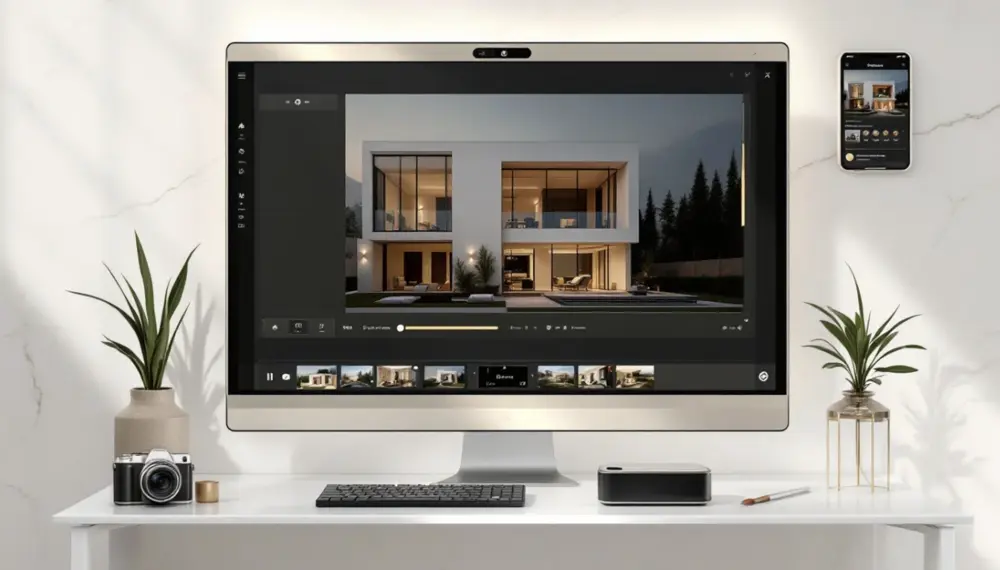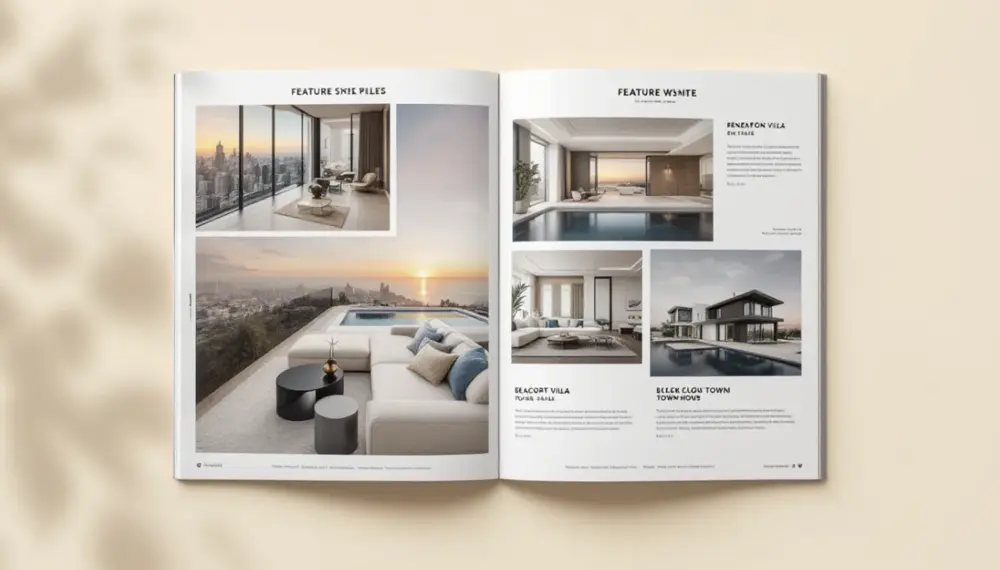Mastering Professional Real Estate Photography – Tips for Stunning Listings
Why is real estate photography so crucial? It turns property presentations into eye-catching advertisements that attract potential clients and help sell properties faster and for higher prices. In this guide, you’ll learn about the essential equipment, preparation tips, shooting techniques, and post-production tricks to deliver stunning visual content.
Introduction to Real Estate Photography
Real estate photography is a specialized field that focuses on producing high-quality visuals of properties for sale or rent. The primary goal is to highlight the property’s best features and appeal to those looking to make a purchase. High-end visuals can significantly impact how quickly a property is sold.
A skilled real estate photographer knows how to make the most of available light, thoughtful composition, and editing methods to produce visuals that emphasize the property’s key qualities. This involves taking photos of both the inside and outside of the property, including rooms, spaces, and outdoor areas. By preserving the essence of the property, these visuals help future homeowners imagine themselves living in the space, ultimately driving interest and engagement.
Key Takeaways
● Investing in quality tools like advanced gear, lenses, and the right setup is essential for producing stunning property visuals.
● Preparing properties through cleaning, decluttering, and staging significantly enhances their visual appeal, making them more desirable on the market.
● Effective marketing, including engaging social media content and optimized online presentations, is crucial for highlighting property visuals and increasing audience interest.
● Offering tailored visual packages to meet different client needs and property specifications ensures organized and efficient management of visual services.
Understanding the Role of a Real Estate Photographer
A visual content specialist plays a crucial role in presenting a property’s appeal to interested parties. Their primary responsibility is to produce high-quality visuals that accurately represent the property’s features and condition. This requires a strong grasp of natural exposure, framing, and editing methods to deliver visuals that stand out.
In addition to technical skills, a visual specialist must work efficiently and effectively to deliver high-quality results within a tight deadline. They often collaborate with realtors, agents, and property owners to understand their specific needs and requirements, ensuring that the final visuals meet expectations and enhance the property’s marketability.
Essential Tools for Professional Real Estate Photography
Achieving high-level visual results requires the right tools, such as advanced gear, lenses, tripods, and proper setup. Digital SLR devices are favored for their sharp output and flexibility, while mirrorless models are gaining popularity for their lightweight design and fast autofocus.
Investing in quality equipment will set the foundation for producing stunning property visuals. Additionally, enhancing dynamic range by blending multiple exposures with the same framing can elevate the final outcome. Using software like Photoshop is a great option for merging these composite visuals effectively.
● Choosing the Right Camera and Lens
Choosing the right equipment plays a vital role in producing high-quality property visuals. For example, a full-frame device paired with a 16–35mm lens designed for broader views works well for photographing spacious interiors and effectively includes three walls in a shot, making it perfect for small spaces.
Maximizing the sense of space by shooting from doorways and keeping the camera level helps avoid distortion, ensuring sharp visual results and impressive photos.
● Importance of Tripods and Stabilization
Tripods are crucial for producing sharp, blur-free visuals, particularly in dim environments and when working with HDR techniques. They enhance stability, improve composition, and reduce perspective distortion.
Incorporating a tripod into your gear, whether you’re highly experienced or just starting out, can make all the difference.
● Illumination Tools for Property Visuals
Enhancing the appeal of visual content hinges on proper illumination. External flashes brighten rooms with insufficient daylight, while reflectors add depth and dimension by redirecting brightness onto shadowed areas, transforming spaces to appear more spacious and inviting.
Investing in quality gear is one of the best strategies for capturing helpful tips that lead to exceptional property visuals.
Preparing the Property for a Photo Shoot
Preparing the property is vital in producing high-level visual content. High-quality results depend on careful composition, effective illumination, detailed close-ups, and thoughtful staging. Cleaning, decluttering, home staging, and selecting optimal shooting times are essential for emphasizing the property’s appeal. Building a shot list ensures all necessary visuals are captured during the session, enhancing efficiency and organization.
Such preparations draw attention to standout elements and establish a neutral atmosphere where future homeowners can envision themselves.

● Cleaning and Decluttering
A clean and decluttered space enhances visual appeal and promotes a sense of spaciousness. High-quality pictures can significantly influence how the property is perceived, making it crucial to present a tidy and well-organized home. Removing personal items helps establish a neutral environment where potential residents can imagine themselves living.
This step ensures the property looks its best and appeals to a broader range of clients.
● Home Staging Tips
Home staging as a specialized service highlights the creative potential of a property, helping future occupants imagine themselves in the space and understand room sizes. Offering home staging services may attract more affluent clients and draw in higher-end clientele.
This crucial aspect of visual presentation involves redecorating and rearranging furniture to elevate how the property is perceived, as a visual expert can effectively present these improvements.
● Optimal Shooting Times
Optimal times for property shoots are early morning or late afternoon when the light is softer. Shooting on a cloudy day offers good lighting, though the sky may appear dull. Soft, diffused sunlight through large windows during the day enhances the space.
Timing your session to leverage these lighting conditions can significantly improve your shots.
Techniques for Capturing Stunning Professional Real Estate Photos
Capturing stunning property visuals demands a blend of technical skill and artistic vision. Properly preparing the property, effective staging, and good lighting conditions are crucial. Techniques like meticulous composition, working with ambient daylight, and managing color temperatures can elevate your visuals. Capturing each scene effectively is essential to enhance the overall appeal of the property visuals.
These proven methods will help you capture photos that leave a lasting impression on interested viewers.

● Composition and Framing
Composition and framing are fundamental in visual work related to property. The rule of thirds divides the frame with vertical and horizontal lines to achieve balanced visuals. Placing prominent architectural elements along these lines results in visual harmony. Aligning horizon lines with horizontal golden ratio lines ensures balance in panoramic shots.
Incorporating elements like doorways or arches can frame the subject and add depth, significantly enhancing the quality of your visuals. Additionally, shooting during the early morning or late afternoon, known as the golden hours, can form soft shadows that enhance the appeal of property visuals. Properly exposing for shadows in High Dynamic Range (HDR) imaging is also crucial for achieving balanced and vibrant final results.
● Utilizing Natural Light
Natural light is a powerful tool in visual content creation, enhancing color, texture, and architectural details. Effectively using natural light involves scheduling shoots during golden hours—early morning or late afternoon – when the light is soft and flattering.
This approach transforms your photos and highlights the beauty of the rooms.
● Managing Color Temperatures
Managing color temperatures is vital for maintaining the integrity of real estate photos. Using one type of light when photographing a space ensures consistent color temperatures and avoids unwanted color casts.
Varying light sources can complicate post-processing and make editing time-consuming. A consistent lighting approach simplifies the editing process and enhances the final results.
Post-Production Editing for Real Estate Photos
Post-production editing is crucial for enhancing the quality and appeal of real estate photos. The aim is to improve image quality, correct perspective distortion, balance color, and crop images. Advanced techniques like HDR editing and photo compositing can further enhance lighting and detail. Post-production editing plays a significant role in enhancing a property’s appeal by creating captivating images that attract potential buyers and effectively showcase the unique features of a property.
However, avoiding over-editing is important to maintain a realistic representation of the property.

● Best Software for Editing Images
Popular software options for editing real estate photos include Lightroom and Photoshop, known for their powerful editing capabilities. These tools are excellent for correcting perspective distortion and performing HDR editing. When selecting software, consider free trials, personal preference, and the specific needs of your photography. Proper editing can have a major impact on achieving high-end visual results.
These tools are indispensable for visual content creators aiming for exceptional visual results.
● Common Editing Techniques
Common editing techniques in visual property work include correcting perspective distortion, balancing color, adjusting contrast, and cropping visuals. These adjustments enhance the overall look and feel of the photos, making them more appealing to interested viewers.
Effectively utilizing these techniques can significantly improve the final visuals, ensuring they stand out in promotional content and marketing materials.
● Avoiding Over-Editing
While editing is essential, avoiding over-editing is crucial to maintaining a touch of realism. Over-editing can lead to unrealistic representations that may disappoint interested viewers during in-person visits.
Striking a balance between enhancing photos and preserving their natural look is key to successful post-production.
Advanced Real Estate Photography Techniques
Advanced techniques can elevate your visual approach. Photo compositing blends multiple images to enhance lighting and improve the overall look. Virtual tours and 3D renderings provide immersive experiences, allowing viewers to create images of properties from every angle.
These methods can significantly boost audience engagement and interest in online presentations. Having a skilled team to execute these advanced techniques effectively ensures high-quality results and maximizes the impact of your visual content.
● HDR Photography
HDR photography merges several images of the same shot taken at different exposures to ensure balanced lighting, effectively capturing both bright exteriors and darker interiors.
Using HDR photography can enhance the visual impact of your real estate photos, making them more appealing to interested viewers.
● Virtual Tours and 3D Imaging
Interactive walk-throughs and 3D visuals offer innovative ways to showcase properties. A 3D Matterport experience lets visitors explore every angle of a property, enhancing visualization and engagement. Virtual staging uses 3D technology to fill empty spaces with furniture and decor, making them more appealing to interested viewers.
Virtual staging is especially useful in unfurnished homes, helping people better understand the potential of each space without the need for physical setup.
These tools can significantly enhance the marketing of property presentations.
Working with a Professional Real Estate Photographer: What to Expect and Why It Matters
Working with an experienced property photographer can make a significant difference in the quality of the visual content and the overall marketing strategy. A skilled photographer will have the necessary equipment, expertise, and experience to capture high-quality visuals that showcase the property’s best features.
They can provide expert tips and advice on how to prepare the property for the photo shoot, including staging, lighting, and furniture arrangement. Those offering property photography services often include options such as interactive 3D experiences, drone photography, and editing solutions to help strengthen the property’s online presence.
By working with a seasoned photographer, property owners and agents can gain a strong position in the market and draw in a wider audience. The investment in high-end visual services pays off by making online presentations stand out and driving higher engagement from interested viewers.
Marketing Your Real Estate Photos
Effective marketing of your real estate photos is crucial for attracting interested viewers. Utilizing targeted social media advertising, designing engaging marketing materials and brochures, and leveraging online platforms are key strategies. Additionally, producing professionally recorded and edited vertical videos tailored for Instagram Reels can be highly effective in gaining followers and generating quality leads through engaging video content.
These approaches increase visibility and engagement, ensuring your listings stand out in a competitive market.

● Creating Engaging Social Media Content
Sharing engaging social media content (read more: Is Real Estate Social Media Essential for Success?) showcases real estate photos to a wider audience. Effective marketing strategies on platforms like Instagram can maximize engagement and attract interested viewers.
Professional feature sheets and brochures enhance the appeal of your listings, providing key information at a glance. These expert tips will help you create compelling content that stands out.
● Designing Feature Sheets and Brochures
Feature sheets and brochures with high-quality images and detailed descriptions effectively attract potential buyers. Including a clear call to action encourages clients to engage further with the listings. These materials showcase the unique features of a property and provide key information to buyers.
● Leveraging Online Listings
Optimizing online listings with targeted keywords significantly increases search visibility and attracts more interested viewers. Including high-quality photos and detailed descriptions enhances buyer interest and engagement. Regularly updating listings with fresh content ensures they remain relevant and continue to attract views.
These strategies provide a competitive advantage in the real estate market.
Conclusion
Mastering high-level property visuals requires a combination of the right tools, meticulous preparation, and advanced techniques. A professional real estate photographer understands the importance of selecting the proper equipment, preparing the property effectively, and photographing each room with thoughtful composition and lighting. Capturing photos in this way, followed by careful post-production editing, results in stunning real estate photos that attract interested viewers. Marketing these photos through engaging social media content, well-designed feature sheets, and optimized online listings further enhances their impact. These strategies ensure that your listings stand out, increasing buyer interest and engagement.
FAQ
What type of camera is best for real estate photography?
For real estate photography, digital SLR cameras are ideal for their high image quality and customizability, while mirrorless cameras offer a lightweight design and fast autofocus. Choosing between these options depends on your preference for handling and feature sets.
Why is a wide-angle lens recommended for real estate photography?
Ultra-wide equipment is recommended for real estate photography because it effectively captures spacious interiors, making small rooms appear larger and more inviting to interested viewers. This approach enhances the overall appeal of the property.
What are the benefits of using tripods in real estate photography?
Using tripods in real estate photography ensures stability and sharpness, particularly in low-light settings, while also minimizing perspective distortion. This results in high-quality images that effectively showcase properties.
How can I ensure consistent color temperatures in my real estate photos?
To ensure consistent color temperatures in your real estate photos, use one type of light source throughout your shoot to prevent unwanted color casts. This approach will help create uniformity in your images.
What are the advantages of virtual tours and 3D imaging in real estate photography?
Virtual tours and 3D imaging enhance engagement by offering immersive experiences that allow interested viewers to explore properties in detail from every angle, ultimately increasing interest in the listings.


